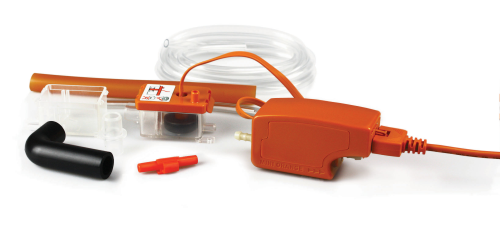
The digital edition of the magazine is distributed free of charge to readers who meet our qualifying criteria. You can apply to receive your free copy by completing this short registration form.
Historically gravity drains have been used in the removal of condensate water from air conditioning units, however, in many applications this seemingly simple solution can prove anything but simple to install and can pose potential health and safety risks. One effective solution to this problem is a condensate pump, Aspen Pumps explains.
Where to install the pipe? When installing air conditioning (AC) systems, engineers have often had to face the headache of where to install the pipe to remove the condensate. Traditionally, a gravity drain was considered a simple solution for condensate removal. However, in reality, on site, a gravity drain can often prove anything but simple to install…
Gravity drain
Condensate is a natural by-product of the cooling process. So when fitting an AC system, whether in a commercial, industrial or domestic application, engineers have to consider the evacuation of condensate water generated by the AC unit. In some cases it may be drained with a Plastic pipe leading away from the system. However, this traditional method has many potential disadvantages, such as water damage issues, space limitations and inflexibility of installation.
For instance, installing gravity drains in new buildings can prove tricky if this has not been considered at the design stage. Adding air conditioning to a building as an after- thought once complete can also prove challenging. Gravity drain systems require the AC unit to be placed on the wall that is nearest to the outside wall and also require sufficient space to drain by gravity. However, without planning where to position a gravity drain in advance AC units may end up installed some distance from outside walls or in space restricted plant rooms, thus making it tricky to use gravity drains to remove condensate.
Other disadvantages of using a gravity drain system include potential water damage to the building. Leaking water from gravity drain systems can damage a building’s façade costing the building’s owner tens of thousands of pounds in repairs to the structure’s exterior.
In addition, there are also health & safety risks that can be caused by gravity drains. For example, stagnant water can pose a health and safety risk due to potential bacterial and fungal growth.
The solution
So what’s the answer? In a bid to meet the global rise in the requirement for comfort air conditioning while answering the challenges posed by gravity drains, the AC industry realized it needed to devise an alternative method of condensate removal which was both fast and reliable. Manufacturers therefore considered these problems and as a result an alternative solution was introduced to the market: the condensate water removal pump.
The advent of this technology was revolutionary in air conditioning since it increased the number of applications that AC could be utilized in, plus made retrofitting units in older buildings simpler. Condensate removal pumps have proved that there is no longer a need for gravity drain systems, since a pump can evacuates water up and away from the AC unit.
Adrian Thompson, CEO of Aspen Pumps said, ‘When retro fitting a AC unit into a commercial building in the UK, in most cases a gravity system is not a viable option. Fitting a condensate removal pump gives complete installation flexibility, without limitations. It’s a no brainer really.’
The development of condensate removal pumps in the AC market has given engineers, installation flexibility allowing them to fit a pump either in, on or above the air conditioning unit thus allowing the water to be pumped up and away from the unit without the need for gravity. These pumps can simply and effectively remove condensate water whatever the application, whether in a flat on the 30th floor of a building, or in the basement of an office block.
Ultimate flexibility is guaranteed with a condensate removal pump, as the unit inside the room can be placed anywhere as desired by the building owner or contractor unlike gravity drain systems which require the unit to be placed on the wall that is nearest to the outside wall . For example, the Silent + Mini Orange from Aspen Pumps can pump condensate water up to 10 m straight up and is as quiet as 19DBA – ideal for installation in a commercial building.
Innovative products
Serge Becker, sales and marketing director at Aspen Pumps said, “Aspen Pumps provides innovative products that help to solve a world-wide problem. In many countries gravity drain systems have been the only way to evacuate the condensate water from a building which can lead to water damage and has potential health and safety issues. Condensate removal pumps provide an easy to install alternative, which require very little maintenance.”
Condensate removal pumps are now available globally for a variety of applications. When space is an issue, there is a pump for nearly all eventualities whether it is needed inside a wall-mounted AC unit; to fit neatly inside elbow trunking; installing above the ceiling; or if it needs to pump water to a higher head, for example like Aspen’s new Hi-Flow 2 l tank pump.
Ticking all the right boxes for engineers and building owners alike condensate removal pumps reliably remove condensate while avoiding the installation issues and the risk of water damage caused by gravity drainage - thus proving that sometimes the traditional ways are not always best…
The digital edition of the magazine is distributed free of charge to readers who meet our qualifying criteria. You can apply to receive your free copy by completing this short registration form.





